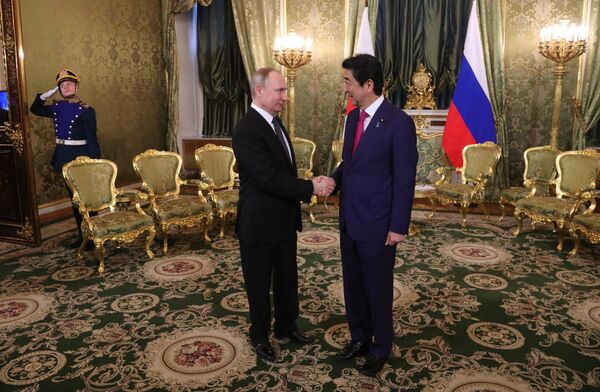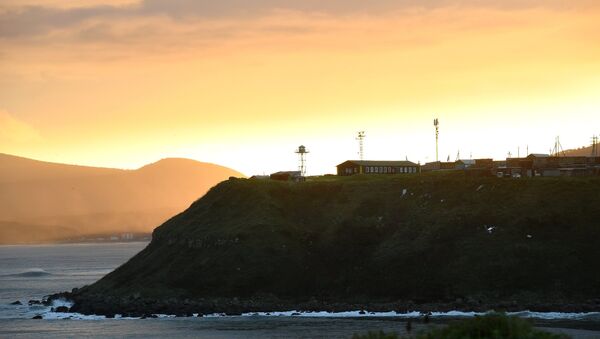The problem of signing the peace treaty, which would include the solution of the issue of border demarcation, has long been a specific feature in Russia-Japan relations.
The main obstacle standing in the way of an agreement is Japan’s unjustified territorial claims to the South Kuril Islands — Iturup, Kunashir, Shikotan and Habomai. The Kuril Islands are claimed by both Russia and Japan. However, all of the islands are under Russian jurisdiction.
READ MORE: Abe Unlikely to Move on Putin's Treaty Proposal Before Election — Ex-Envoy
Southern Kurils are an archipelago of volcanic islands, which separates the Sea of Okhotsk from the Pacific Ocean, stretching from the northeastern corner of Japanese Hokkaido Island to Russian Kamchatka Peninsula. They consist of two parallel groups of islands, Greater Kuril Ridge and Lesser Kuril Ridge. The Kuril Islands were first mentioned by a 17th-century Russian explorer Vladimir Atlasov. Most of the Kuril Islands were mapped in 1745.
READ MORE: Putin Offers Abe Peace Treaty, Japan to Proceed After Kuril Islands Issue Solved
The Japanese moved to the Northern Kurils in parallel with the development of the Kurils by Russia. Rebuffing the Japanese onslaught, Russia built a fortified military camp on the island of Urup in 1795. A dual power actually formed on the Kuril Islands by 1804 — the influence of Russia was felt more strongly in the Northern Kurils, while the Japanese influence — in the South. But formally all the Kurils still belonged to Russia.
On January 26, 1855, the first Russian-Japanese treaty was signed in the Japanese city of Shimoda, the Treaty of Shimoda, formally the Treaty of Commerce and Navigation. It proclaimed the relations of peace and friendship between the two countries, opened three Japanese ports for Russian ships and established a border in the South Kuril Islands between the islands of Urup and Iturup.
READ MORE: Japan Submits Note of Protest to Russia Over Festivities in S Kurils — Official
The Kuril Islands were under Japanese rule from 1875 till 1945.
On February 11, 1945 the leaders of the Soviet Union, the United States and the United Kingdom signed an agreement, according to which in exchange for the participation of Soviet troops in the war against Japan, the Kuril Islands and South Sakhalin, lost in the Russian-Japanese War of 1904-1905, were to be transferred to the Soviet Union.
On September 2, 1945, Japan signed the act of unconditional surrender, accepting the conditions of the Potsdam Declaration of 1945, according to which its sovereignty was limited to the islands of Honshu, Kyushu, Shikoku and Hokkaido as well as the smaller islands of Japanese archipelago. The islands of Iturup, Kunashir, Shikotan and Habomai passed to the Soviet Union. The Soviet Union did not sign a peace treaty with Japan at the San Francisco Conference in 1951, saying that there were no clear indications that Southern Sakhalin and the Kuril Islands had become sovereign territories of the Soviet Union in the document.
The refusal to sign the peace treaty had serious diplomatic consequences. Taking advantage of this fact, Japan, as recommended by the United States in 1955, made claims to the Soviet Union for all the Kuril Islands and Southern Sakhalin, referring to the bilateral Treaty on Trade and the Borders of 1855. As a result of the two-year negotiations, the positions of the two countries became closer and Japan limited its claims to the islands of Habomai, Shikotan, Kunashir and Iturup.
READ MORE: Japanese Lawmaker Reveals What Will Help to Resolve Kurils Issue
On October 19, 1956, the Joint Declaration of the Soviet Union and Japan was signed in Moscow on ending the state of war and the restoration of diplomatic and consular relations. The Soviet leadership decided to note in the document that in meeting the wishes of Japan and taking into account the interests of the Japanese state, Moscow agrees to transfer the islands of Habomai and Shikotan to Japan, however, the transfer itself will be made after the conclusion of a peace treaty between the parties.
A protocol on the development of trade with the mutual granting of the most favored nation treatment was signed simultaneously with the declaration.
After the conclusion of the Japanese-US treaty on the security in 1960, the Soviet Union annulled the commitments made in 1956 declaration.
Later the Soviet side said that the territorial issue in relations between the Soviet Union and Japan was resolved as a result of World War II.
In April 1991, following the official visit of Soviet President Mikhail Gorbachev to Japan, a joint Soviet-Japanese statement was signed. The Soviet Union for the first time officially recognized the existence of a territorial problem in relations with Japan, stressing the importance of speeding up the work on the completion of the peace treaty, using experience in bilateral negotiations, beginning with the Joint Soviet-Japanese Declaration of 1956.
A new stage in Russian-Japanese relations began after the collapse of the Soviet Union. In 1993, Russian President Boris Yeltsin made an official visit to Japan. The Tokyo Declaration, according to which the parties agreed to "overcome the heavy legacy of the past in bilateral relations" and "to conclude an early peace agreement by resolving the issue" in order to fully normalize bilateral relations, was signed during the talks on October 13.
The presidents of Russia and Japan repeatedly returned to the issue of the peace treaty and the territorial problem in subsequent years, but still, there were no results, since the positions of the parties have been diametrically opposed.

Japan claims the islands of Iturup, Kunashir, Shikotan and Habomai, referring to the bilateral Treaty on Trade and Borders of 1855. Moscow’s position is that the Southern Kurils have become part of the Soviet Union following World War II and Russian sovereignty over them was established under international law.
According to the Joint Declaration of 1956, the transfer of Habomai and Shikotan to Japan was specified and the fate of Kunashir and Iturup was not mentioned. Experts believe that distinction of the status of the two pairs of islands in this document created the main difficulties for the entire negotiation process over the 60 years. The idea of transferring two islands at first, as it was specified in the 1956 declaration, was discussed at a meeting between the leaders of Russia and Japan, Vladimir Putin and Yoshiro Mori, in 2001, but with Junichiro Koizumi’s coming to power, the idea was postponed.
Japanese Prime Minister Shinzo Abe announced in October 2016 that he was proposing Putin to take responsibility and jointly promote negotiations to resolve the issue of the peace treaty.
During Putin’s visit to Japan in December 2016, the leaders agreed to launch negotiations on the establishment of joint economic activities in the South Kuril Islands. Putin noted that such cooperation will help create a favorable atmosphere for the continuation of negotiations on concluding a peace treaty. In February 2017, the Japanese Foreign Ministry established a council for joint economic activities. Implementation of joint projects is considered in such areas as mariculture, greenhousing, tourism, wind energy and waste treatment. According to the agreement, this activity should not violate the legal positions of both countries.
On September 12, 2018, Putin, speaking at the plenary session of the Eastern Economic Forum, proposed Japan to sign a peace treaty before the end of the year without any preconditions. He suggested including a provision on Moscow and Tokyo’s commitment to settle disputes on the territorial issue within the text of the document.




